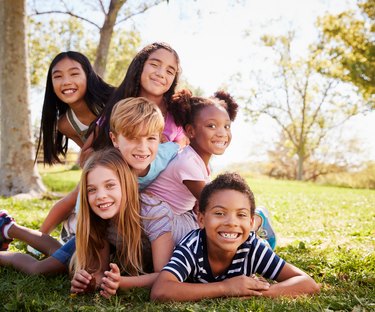Many people think that Sjögren’s disease only affects adults — but children can get Sjögren’s disease too. What’s more, it’s likely that childhood Sjögren’s is underdiagnosed. That means there are likely many children with Sjögren’s disease who don’t know they have it.
Learning the signs and symptoms of Sjögren’s disease in children can help parents and caregivers advocate for their child to get diagnosed and get the care they need.
Signs and Symptoms Experienced by Children with Sjögren’s
Sjögren’s disease causes a wide range of symptoms and can affect any part of the body. Children tend to experience different symptoms than adults who have Sjögren’s.
Dryness symptoms can occur but are often less prominent than in adults.
Common symptoms of Sjögren’s for children include:
- Recurrent parotid gland swelling (parotitis)
- Joint or muscle pain or tenderness
- Fatigue
Other less common symptoms children may experience include:
- Eye problems, including dry eyes, corneal ulcers (open sores on the clear surface of the eye), and infections
- Mouth problems, including dry mouth, mouth sores, tooth decay, trouble chewing and tasting, and trouble speaking
- Nose problems, including dry nose, frequent sinusitis, and nosebleeds
- Difficulty with eating or digestion, including trouble swallowing, upset stomach, heartburn, acid reflux, and inflammation of the esophagus (the tube that moves food from the mouth to the stomach)
- Skin problems, including dryness and rashes
- Nervous system problems, including trouble thinking or concentrating, memory loss, headaches, and nerve damage
- Vaginal dryness and irritation in female patients, which may result in recurrent yeast infections
- Fevers and unintended weight loss
- Swollen or enlarged lymph nodes, which can be more common in children than adults with Sjögren’s
- Easy bruising or bleeding, which can be a sign of low platelets
- Trouble breathing, which is uncommon but can occur if the lungs are affected
- Poor growth or muscle weakness, which can be signs of certain kidney inflammation causing renal tubular acidosis
Children naturally produce more tears and saliva than adults, which means noticeable dryness may not show up early in the disease. This may be one reason that dryness symptoms are less common in younger children and may appear only as a child gets older. A child’s Sjögren’s disease symptoms may change as they get older. Because children may not have a baseline comparison for what “normal” moisture feels like, many do not recognize or describe dryness the same way adults do.
If you’re a parent or caregiver of a child with these symptoms, talk with their doctor about your concerns and whether a referral to a specialist, such as a pediatric rheumatologist, may be helpful to further evaluate the possibility of Sjögren’s disease.
Diagnosing Sjögren’s in Children
Getting diagnosed with Sjögren’s disease can be a challenging process for children. Because Sjögren’s is not thought of as a disease that commonly affects children, doctors might not always consider it when trying to find what’s causing a child’s symptoms. If you think your child might have Sjögren’s, talk with their doctor about your concerns, and ask about Sjögren’s specifically.
Many adults diagnosed with Sjögren’s later in life recall that their earliest symptoms began in childhood or young adulthood. In research studies, more than half of adults reported that their symptoms appeared long before they were officially diagnosed.
Diagnosing Sjögren's in general is challenging because the diagnosis relies on abnormal testing in several different types of tests. There is no one test that can tell us if someone has Sjögren's or not. Diagnosing Sjögren's in children is uniquely challenging because the common tests used to diagnose Sjögren's in adults may not be abnormal in children as they rely heavily on measuring eye and mouth dryness.
There are steps you can take to help your child’s doctor determine if they have Sjögren’s disease. Keeping track of your child’s symptoms can help their doctor get a better picture of their health and help determine if Sjögren’s disease might be causing their symptoms. To keep a symptom log, write down:
- When a symptom started
- How long it lasted
- How much it bothered your child
Share the symptom log with your child’s doctor when you visit them. Having a record of your child’s symptoms over time can help your doctor reach a diagnosis.
You can also consider asking your child’s doctor to refer your child to a pediatric rheumatologist to check for Sjögren’s disease. Pediatric rheumatologists are doctors who specialize in conditions like Sjögren’s in children, and they may be better able to check your child for Sjögren’s disease than your child’s regular pediatrician.
Researchers are also studying how to interpret lip biopsy results in children, since normal biopsy patterns may differ from adults. New pediatric reference standards are being developed to help doctors better understand these results.
Remember — Sjögren’s disease is likely underdiagnosed in children. If you’re having trouble finding a doctor who takes your concerns seriously, consider getting a second opinion from a different doctor or asking for a referral to see a specialist.
Managing Sjögren’s in Children
Managing Sjögren’s disease in childhood is generally similar to managing Sjögren’s for adults. The main goals of management for children are to:
- Prevent pain
- Reduce inflammation
- Prevent long-term damage to the body
Many children with Sjögren’s may need medications to control inflammation. Hydroxychloroquine is commonly used, and some children may require additional medicines such as methotrexate, corticosteroids, or—when symptoms involve major organs or severe parotid swelling— other therapies. Your child’s doctor will help determine the safest and most effective options based on symptoms and organ involvement.
Managing Sjögren’s may involve working to control your child’s immune system and manage their symptoms through medicines or lifestyle changes. If your child has been diagnosed with Sjögren’s, work with their doctor to come up with a treatment plan that works for your child and your family.
It’s important to know that fatigue can be a very challenging symptom for children with Sjögren’s. While treatments may help, fatigue does not always improve completely, so lifestyle strategies and supportive care may also play an important role. Many children find that regular, age-appropriate physical activity can help improve energy levels. Be sure to talk with your child’s healthcare provider to determine what types and amounts of activity may be most appropriate for them.
Your child’s doctor can also help you and your child know what to expect as your child gets older.
Getting Support for Your Family
Childhood Sjögren’s can have a big impact — both on the child with Sjögren’s and on their parents or caregivers and siblings. You or your child may find navigating life with a chronic illness to be challenging at times.
In addition to the recommendations above, mental health support can play an important role in helping children and families cope with the stress, uncertainty, and day to day demands of a chronic condition. Some families find it helpful to meet regularly with a therapist or counselor who has experience supporting children or families navigating chronic illness. If you are looking for a mental health provider in your area, you can search by location, specialty, or insurance at PsychologyToday.com.
Finding a support group for childhood Sjögren’s patients and their families can also give you and your child a place to share about your experiences and connect with other families living with Sjögren’s.
Learn more about support groups for families like yours.
Additional resources:
- Sjögren's in Children (flyer)
- El síndrome de Sjögren en los niños (flyer)
- Pediatric Sjögren's Education Sheet
The Sjögren’s Foundation: Supporting Research on Childhood Sjögren’s
Childhood Sjögren’s is an area of active research — and more research on childhood Sjögren’s will help ensure that children living with Sjögren’s are able to get the treatment they need. The Sjögren’s Foundation is proud to support researchers who are working to improve our understanding of Sjögren’s disease in children.

Join the Sjögren's Foundation
Join as a Foundation Member to add your voice to ours and strengthen this organization as we advocate for all patients! Foundation members enjoy exclusive member benefits including a subscription to our bimonthly newsletter Conquering Sjögren's, information about new products and clinical trials, access to the member's only side of the website and much more!
Click Here to Become a Member